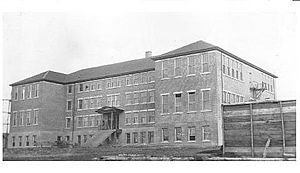Lejac Residential School facts for kids
The Lejac Residential School was a special type of school in British Columbia, Canada. It was part of a system called Canadian residential schools. These schools were set up by the Government of Canada and run by different churches. Lejac School was operated by the Roman Catholic Church. It was open from 1922 until 1976.
The school was built in 1922. It took the place of an earlier school that opened in 1917 in Fort St. James. Lejac Residential School was located right by Fraser Lake. It was near the railway line and not far from the First Nation villages of Stellako and Nadleh. Most of the people who worked at the school were from the Catholic Church. The school was named after Father Jean-Marie Lejacq, who was a missionary.
Most of the students at Lejac School were from the Carrier people. But students from other nearby Indigenous groups, like the Sekani and Gitksan, also attended.
Life at Lejac School
Like many other residential schools, Lejac School had a difficult history. Some former students have shared stories about being treated poorly while they were there. These experiences were very hard for them.
After the school closed in 1976, the land was given to the Nadleh Indian Band. The school buildings were taken down. Today, there is a cemetery and a special memorial at the site. Every year, people visit the site to remember Rose Prince. She was a Carrier girl who lived and worked at the school. Some people believe she might become a saint.
Tragic Events at the School
Sadly, some children died while they were at residential schools, including Lejac. One very sad event happened on New Year's Day in 1937. Four young boys ran away from the school. They were Allen Willie (8 years old), Andrew Paul (9 years old), Maurice Justin (8 years old), and Johnny Michael (9 years old).
The boys left without warm hats and were not dressed for the cold weather. They walked about six miles across a frozen lake. But they could not make it all the way to the Nadleh reserve. They were found later, having frozen to death because of the extreme cold.
An Indigenous musician named Marcel Gagnon has created music to honor these boys. His album, "New Years Day," tells their story.
See also


